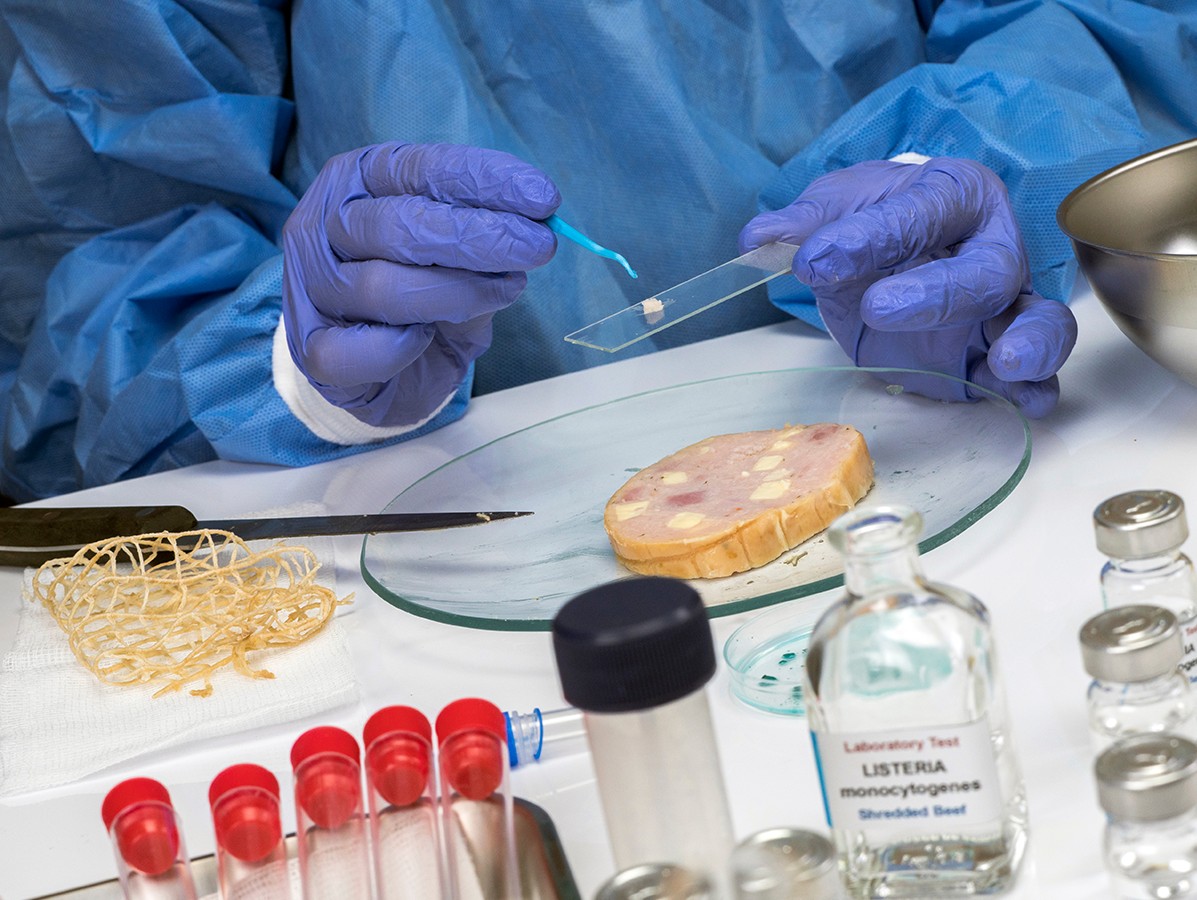
The presence of Listeria is inherent to working with food. In order to control the bacteria, everything is pulled out of the cupboard: from adjusting the recipe to dry disinfection.
"The situation has not become any simpler," says René Bakker about the risk of a Listeria infection among food producers. He is an account manager at Hago Food & Industry, a specialist cleaning company that operates in the food industry. "Due to the enormous growth of ready-made meals, for example, manufacturers have to deal with many different suppliers. Every day they run the risk of bringing in the bacteria." Preventing the presence of Listeria is therefore a utopia, according to Bakker. Other experts in the sector endorse this. "The infection pressure in the sector is high," says Hugo ter Hoeve, director of Simpel Desinfecteren. "Listeria's presence is not a problem up to a certain value, but an outbreak is always on the lookout. Controllability is therefore crucial."
There are several possibilities for this approach. "It starts with the design and construction of a factory and production line," says Bakker. "Wrong constructions, overcrowded production areas, walls that are not tiled or skirting boards that are not properly sealed make cleaning more difficult. Before we work with a customer, we identify such challenges." According to Gert Visscher, director of Eco2Clean, imperfections in the machine park are also a risk. The company supplies cleaning and disinfection products, and advises and supports in their hygiene and cleaning issues. "Old dirt is usually Listeria's fireplace. Every company has blind spots that are forgotten during cleaning and disinfection. Old dirt can be found, for example, in holes drilled into pipes or, as we recently saw, on the underside of the collision protection. Cross-contamination by means of trolleys or splashing dirt during cleaning can lead to contamination of other parts of the company. Listeria can also survive for a long time and at a low temperature. Production equipment that comes out of storage and has not been thoroughly disinfected for reuse is also a danger. Among other things, we set up a customer-specific monitoring programme and provide targeted training to cleaning staff. Our software tool HIMS supports communication between the cleaning team, production and technical service. This enables us to share photos and information about, for example, residue measurements and allergens."

The importance of hygienic design in the food industry is, as already mentioned, great. This applies to all parts of the production area: from the floors, walls and pits to the machines, conveyors and drive systems. Frans Noest, CEO of Dertec, knows that many companies can still achieve (food safety) gains from the latter. His company specialises in electromechanical drive and conveyor technology. "Hygienic design is leading in all our drive systems. So we design without cracks and holes and always with organic forms, so that dirt cannot accumulate. In addition, we opt for electro-polished stainless steel (AISI 316), which results in a smoother surface than a paint or surface coating. In practice, this means that, in general, less aggressive cleaning agents are required for optimal cleaning. Since cleaning in the food industry is often carried out at high temperatures and with high pressure, the drive systems must also be able to withstand this violence. We carry out a great deal of research into this and test the systems in practical situations. But no company is the same: they all have their own cleaning plan and procedures, detergents and installations. We therefore advise new customers to test the drive systems in their own production environment first."
Frans indicates that it remains difficult to find the balance between a good hygienic design and optimal ease of use. "The cooling of engines, for example, usually takes place via cooling fins (the cooling block). Dirt easily accumulates between these fins. That's why we don't use that system. The downside of this choice is that an engine gets a bit warmer. Personnel must of course take this into account. It is often a matter of finding the right balance between improving the engine and of food safety and ensuring occupational safety."
In addition to the production environment, the product itself is also important when it comes to whether or not to increase the risk of an outbreak. "Adapting the recipe is an increasingly common technique to reduce the risk," says Pieter Vos of Nutrilab, who tests samples in his own laboratory for the presence of bacteria such as Listeria. "Some companies adjust their logistics or reduce their shelf life if challenge tests show that the limit value of the permitted quantity of Listeria, the so-called colony-forming units, is exceeded within that expiration date. But I see more and more products with sodium acetate, potassium acetate or lactic acid. These prevent the growth of Listeria. There are two sides to this process: the NVWA demands safe food on the basis of EU legislation, and the retail sector often wants a long shelf life. This development is at odds with the fact that more consumers want to buy unprocessed products. I expect food safety to win in the long run."

Despite a suitable room and low-risk products, Listeria is regularly found during microbiological checks - according to Pieter Vos, the bacterium was also found on meat substitutes. A thorough cleaning and disinfection to control the problem are literally of vital importance. Of course, first the source of the contamination has to be removed, then everything has to be cleaned and disinfected properly. At Qlean-tec | Christeyns, a manufacturer of detergents, they have about 250 products at their disposal for the food industry. Leo Frings, Director of Sales & Marketing, explains: "With the right combination of traditional products such as Mida Foam 171 MD and innovative enzymatic products, microbial infections can be tackled. This increases safety and extends shelf life." An example of a microbial contamination in which Listeria can also hide is a biofilm: a layer of micro-organisms surrounded by a self-produced mucus, which adheres to a surface such as worktops or tiles. Biofilms are often difficult to detect and are a danger if they are accidentally broken open during the production process. In addition, traditional cleaning and disinfection agents are usually unable to destroy and remove their structure. Frings has seen an increase in attention to the risk of biofilms in recent years. Awareness of the importance of proper cleaning and disinfection is better than before, he says: "The awareness that hygiene is part of the product, in relation to the expiration date, Shelflife and the guarantee of food safety, is beginning to come.
The increasing awareness is also reflected in an increasing demand for solutions that are less harmful to the environment. Frings: "Ultrasonic, for example, is a penetrating, mechanical cleaning process that requires less chemistry. Much testing is already being done with UV and plasma, for example by us in collaboration with Wageningen University, with whom we also collaborate in research projects, but these methods are still difficult to apply at present."
Another way of disinfection is through dry infection. A relatively new technique in the food industry, which has been used in the medical world for much longer. Simpel Desinfecteren supplies devices that, at the push of a button, emit a dry and environmentally friendly vapour based on hydrogen peroxide, which falls apart into ions, which in turn go in search of organisms, the bacteria. "The ions are found wherever oxygen can be found, even under and in machines. In this way, they disinfect the entire production area and everything in it, including the evaporators, from floor to ceiling. And there is no residue left," says director Ter Hoeve. According to him, thorough pre-cleaning is a must for a clean end result: "Otherwise our device will disinfect the dirt." The human factor, which is a risk anyway, is eliminated with the Simpel Desinfecteren devices. Ter Hoeve: "Disinfection is the last step in the cleaning process. The cleaning staff wants to go home quickly, or the production is up and running already. Not infrequently time and therefore the quality of the disinfection is under pressure. Our machines do the same thing every day."
René Bakker (Hago Food & Industry) also receives more and more requests to shorten the cleaning time. "The Netherlands is doing well in terms of production; volumes are increasing because of the demand. Manufacturers are therefore deploying extra production teams, which is why the cleaning time is under pressure. The other day, I had to say 'no' to a customer when he asked me to do the cleaning in five hours instead of the agreed six hours. At the same time, we are asked whether we can clean Listeria-free. Giving this guarantee is difficult, because the production process and a hygienic design are also very important for this. Providing us with insight into the measurement results from the lab is also relevant. Then we can see how things are progressing and, if necessary, adjust our policy accordingly. It really is a shared responsibility."
Photo lab: ©felipe caparros/Shutterstock.com, photo sky: ©Maren Winter/Shutterstock.com, photo puzzle: ©carlos castilla/Shutterstock.com
Source: © Vakblad Voedingsindustrie 2019